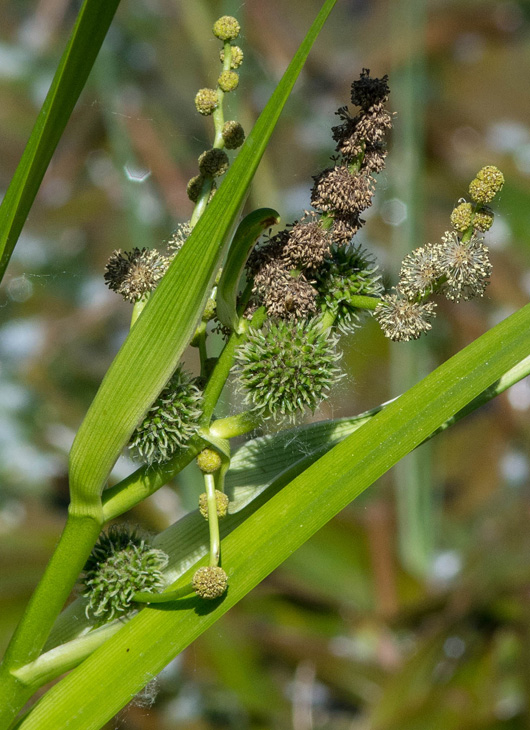Sparganium
|
Family: Typhaceae |
Herbs, erect or floating, or sometimes with some leaves floating and some emergent. Leaves flat, plano-convex, or abaxially keeled and V-shaped in section, spongy, margins entire. Flowers wind-pollinated, odorless, sessile. Fruits sessile or stipitate; tepals persistent, attached at base, in one species partially adnate to stipe. Seeds 1--2(--3), slender-ovoid; coat thin, appressed to endocarp. x = 15. The plants flower in late spring to late summer, and the flowering season is shorter northward and at higher elevations. Fruiting is in late summer and fall, and some plants flower and fruit simultaneously in late season, especially northward and at higher elevations. Occasional plants have only staminate flowers. Mature fruits are needed for identification of some species. The tepals, style, and often the stigmas remain attached to the mature fruits; the persistent style and stigma formis the beak. The staminate rachises often persist, and the location and numbers of staminate heads can be determined from the scars of the fallen heads, even in fruiting specimens. Some species show great variation, and specimens can be difficult to assign. Most characteristics depart at least occasionally from those given in the key, and foliar cross sectional details are often distorted in dried specimens. In some erect species growing partially submersed, the first leaves of the season are submersed or floating and limp, and later leaves are emergent and stiffer. In species with normally erect leaves, deep or moving waters often suppress flowering and stimulate formation of only long, ribbonl-like leaves that resemble those of species that produce only floating leaves. Species normally having floating leaves sometimes produce partially erect leaves when stranded. Depauperate or deep-water individuals of species that usually bear branched rachises sometimes have simple rachises with shortened internodes, and then the flowers and fruits are often reduced in number, but their morphology is little affected.
The worldwide monograph of Sparganium (by C. D. K. Cook and M. S. Nicholls (1986, 1987) is the most comprehensive treatment; most of their nomenclature is used herein. Nevertheless, the taxonomy must be regarded as tentative in the absence of detailed studies of any species over its full range. Phenotypic, ecotypic, and clinal variation are great in most species, the influence of hybridization is unclear, and some species are but dubiously differentiated from their Eurasian vicariants.
PLANT: Herbaceous monoecious perennials. ROOTS: fibrous. LEAVES: sessile, alternate, 2‑ranked, elongate‑linear, flaccid and floating or stiff and erect, basally sheathing. STEMS: from extensive creeping rhizomes, with erect or floating, simple or branched stems. INFLORESCENCE: of densely flowered, somewhat regularly disposed capitate‑globular, sessile or pedunculate, heads on the upper part of the stem or its branches, with staminate heads above, with pistillate below, subtended by caducous or persistent leaf‑like bracts. STAMINATE FLOWERS: of 3‑5 minute chaffy perianth segments, each subtending a stamen, the filaments slender, free or partly united, much longer than the anthers and greatly exceeding the bracts. PISTILLATE FLOWERS: sessile or shortly pedicellate, with a calyx‑like perianth of 3‑6 linear to spatulate or obovate‑flabellate scales; pistil simple or sometimes 2‑carpellate; style elongate, simple or forked; ovary 1(‑2)‑celled, each locule 1‑ovuled. FRUITS: achene‑like with a strong beak, suborbicular, obovoid, broadly fusiform or truncate‑pyriform, indehiscent, 1‑2 seeded, albuminous with mealy endosperm. NOTES: A monogeneric family with 15‑20 spp. of aquatic habitats; temperate and arctic regions of N. Hemisphere and Australasia. REFERENCES: Ricketson, Jon. 2001. Sparganiaceae. J. Ariz. - Nev. Acad. Sci. Volume 33(1). Characters of the family. 15, mainly N. Temp. Gleason, Henry A. & Cronquist, Arthur J. 1991. Manual of vascular plants of northeastern United States and adjacent Canada. lxxv + 910 pp. ©The New York Botanical Garden. All rights reserved. Used by permission. |

